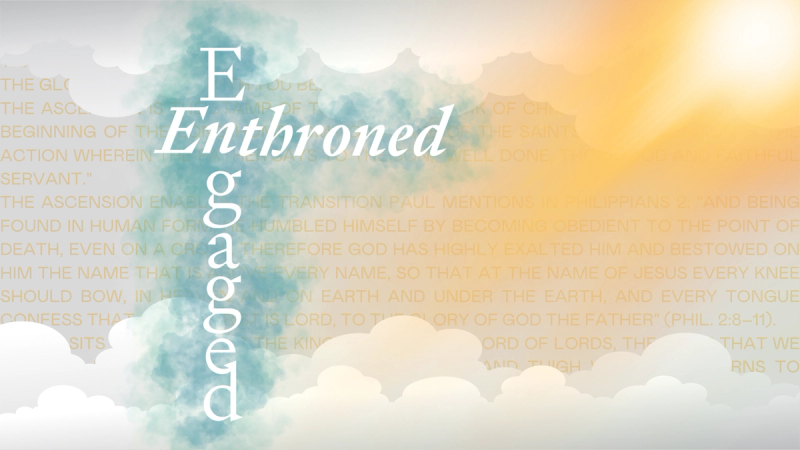If I am honest, I have always thought of the Ascension of Christ kind of like the cherry on the sundae—that is, the few times I have spent time thinking about Christ's ascending from earth back to the Father. In church circles, we spend most of our time talking about the death of Christ. Around Easter, we shift the focus to the resurrection of Christ. In reformed circles, we even do a decent job of talking about the life of Christ. But the Ascension? Sure, we mention it in rote fashion when we recite the Apostle's Creed. But does the reality of the Ascension color our reality?
Where Christ is now matters. The reality that Christ sits at the right hand of the throne of God should significantly inform our moments and our months. The fact that he was lifted from the earth to be reunited with the Father should lift our lives from despondency, despair, and self-dependence.
In both Luke’s Gospel and the book of Acts, the Ascension of Christ holds a prominent place. In Luke, we see the Ascension as the concluding pregnant pause. In Acts, we see the Ascension as the hinge on which the church swings into action. The Ascension reminds us that we serve an enthroned yet engaged Christ.
Enthroned
The Ascension is God's loud, glorious yes to the earnest prayer of Jesus in the high priestly prayer: "I glorified you on earth, having accomplished the work that you gave me to do. And now, Father, glorify me in your own presence with the glory that I had with you before the world existed" (John 17:3).
The Ascension is the stamp of the finished work of Christ. The Ascension is the beginning of the long homecoming parade of the saints. The Ascension is the action wherein the Father says to the Son, "Well done, thou good and faithful servant."
The Ascension enables the transition Paul mentions in Philippians 2:
"And being found in human form, he humbled himself by becoming obedient to the point of death, even on a cross. Therefore God has highly exalted him and bestowed on him the name that is above every name, so that at the name of Jesus every knee should bow, in heaven and on earth and under the earth, and every tongue confess that Jesus Christ is Lord, to the glory of God the Father" (Phil. 2:8–11).
Christ sits enthroned as the King of Kings and Lord of Lords, the name that we will see proudly proclaimed on Jesus's robe and thigh when he returns to usher in the new heavens and the new earth (Rev. 19:16). When the nations ask, "Where is their God?" we respond with confident consonance with the psalmist, "Our God is in the heavens, he does all that he pleases" (Ps. 115:2–3).
Engaged
Yet—and what a glorious yet—our enthroned Christ spends his time deeply engaged with the plight of his pilgrim people. He did not merely check the box, finish the work, and retire to leisure in Cancun (like most of us want to do after we have "completed" our life's work). All that Jesus ever did on earth, he continually does in heaven. After all, there is continuity to his character (Heb. 13:8). He did not stop being a Savior and a Redeemer when he passed through our atmosphere into the heavenly places (without a rocket thruster or an oxygen line).
When Stephen, the first martyr, gets a glimpse into the throne room, do you remember what he sees? It's not a satisfied, disinterested, detached sovereign lazing on his throne; rather, it is an engaged, enthroned Christ:
"But he, full of the Holy Spirit, gazed into heaven and saw the glory of God, and Jesus standing at the right hand of God" (Acts 8:55–56).
Christ is standing, as one actively watching and helping from heaven, as one of his adopted siblings is tortured in his name. I imagine him peering down at Stephen, as if to say, "I see, and I hear, and I know," with eyes full of empathy and assurance.
The writer of Hebrews comforted the early church by reminding them that their High Priest who sat down from his completed work of atonement continues the work of intercession:
"Consequently, he is able to save to the uttermost those who draw near to God through him, since he always lives to make intercession for them" (Heb. 7:25).
Reveling & Resting
We hear often that we need to daily apply the gospel to our lives, but what might it look like to daily remember the reality of our ascended Lord?
The words engaged and enthroned give me handles to help hold the glorious reality of the ascended Christ, as do the words reveling and resting. We are invited to revel in our ascended Lord and to rest in his finished work. He is enthroned and works out perfectly God's sovereign plans for our good and his glory (Rom. 8:28). His work is complete: his done enables and empowers all our doing (Heb. 10:11–14). The same public pleasure that God shows for his Son is available to me and every other saint who hides in the ascended Savior.
Yet, this seated, sovereign Christ is engaged in the warp and woof of our daily lives. Again, we are invited to revel in the reality of a still-engaged Savior and rest under his active gaze over our lives. Though he has finished his work, he remains engaged in the works he entrusted to us (Eph. 2:10; Col. 1:29). He cares about our worries enough to command us to cast them onto his lap continually (Phil. 4:5–7; 1 Pet. 5:6–7). He can sympathize with our weaknesses because he remembers his days in time and space on the globe he created, and we broke (Heb. 4:14–16). He prays into the ear of his Father as One who knows what it is like to be human and far from our intended home with our Triune God. He strengthens our steps until the day he steps from the throne to make all things new.
Were he only enthroned, we would serve a distant, disengaged sovereign. Were he only engaged, we would serve an empathetic yet emasculated leader. But our Christ is both enthroned and engaged, and therein lies all our hope.





